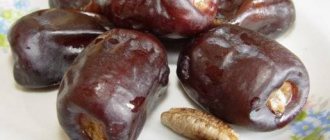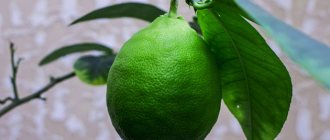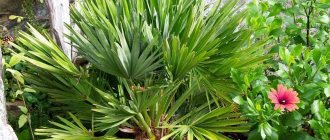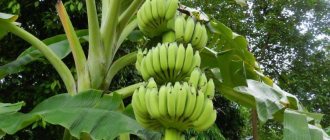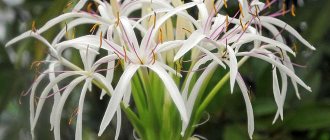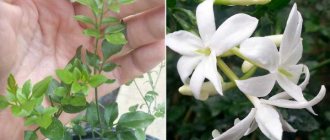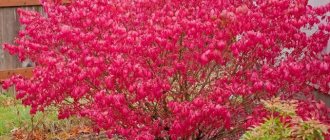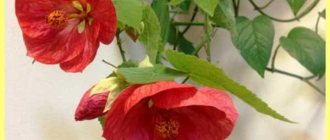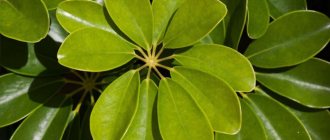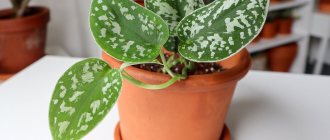What does an indoor banana look like, what family does it belong to?
Southeast Asia is considered the birthplace of the banana. In nature, the height of the trunk reaches 12 meters. Of course, such a giant is not suitable for a home. Therefore, dwarf varieties up to 2 meters high are placed in the apartment. This raises the question: is a banana palm a tree or a grass?
Dwarf varieties
Note! The indoor banana is not a tree or shrub. This is a perennial herb. The fruit is a berry, and not a fruit at all.
Features of the plant:
- height 1.5-2 meters;
- leaves up to 2 meters in full length, with a width of up to 50 centimeters;
- the trunk of the plant is formed by densely superimposing the base of the leaves on top of each other and is a pseudostem;
- the trunk simultaneously acts as a root system and is located underground;
- indoor banana produces a flower from a pseudostem that dies immediately after fruiting.
The tree lives for about 5-6 years.
The berry is widely used in medicine. It is used for cholelithiasis, diseases of the liver and gastrointestinal tract. It has an enveloping effect, which is useful for stomach and duodenal ulcers in case of exacerbation. Fiber helps improve digestion. The potassium contained in the fruits has a beneficial effect on the functioning of the heart.
Important! Scientists note that people who eat bananas have a more optimistic outlook on life.
Initially, bananas grew only in the tropics. At the beginning of the 15th century, they were brought to Europe from Africa by Portuguese sailors. Having begun to propagate them in the Canary Islands, they gradually developed cold-resistant varieties that have spread throughout the world. Since the 16th century, bananas have become popular in the Caribbean and Central America.
Features of caring for indoor bananas at home
Banana palm, what trees do bananas grow on?
At home, fruits grow only if you carefully care for the plant.
Temperature
The tropical native loves the heat. High temperature is vital for it - it should be above room temperature - 25-30 °C, without falling below 15 °C. Low temperatures slow growth and promote disease.
Considering that this is a southern plant, it needs a lot of sun. When caring for indoor bananas at home, windows on the south or east side are suitable. On cloudy days and in winter, backlighting is required. The quality of lighting is directly related to the growth of green mass. In poor lighting, grass growth slows down, fruits stop setting, that is, it will not bear fruit.
Additional lighting
Watering and humidity
It is recommended to water infrequently, but abundantly, to wet all the soil. The indicator is the drying of the top crust of the earth by 1-2 centimeters. If water is taken from the tap, be sure to let it sit for the chlorine to evaporate. Sometimes, instead of watering, you can organize a warm shower, as in the tropics.
Leaves are sprayed daily in summer. In winter, once a week is enough.
The plant is recommended to have a humidity of over 65%. It is difficult to organize at home, so daily wet wiping of the leaves is necessary. High humidity and sun are the main components of successful cultivation.
Priming
The soil requires periodic loosening to allow air to reach the roots and destroy the soil crust. The top layer of soil taken from linden, hazel, birch or acacia is suitable. By adding sand, wood ash and humus, the composition is mixed and calcined. Drainage, sand and then soil are laid out at the bottom of the dish. The soil should be loose, with a neutral PH.
Top dressing
Needs to be fed regularly. Organic substances - vermicompost or herbal infusion - are suitable for this. Organics are supplemented with universal mineral fertilizers. The plant being fed needs to be darkened for a day.
Exotic care rules
For a true fan of indoor plants, there is nothing more enjoyable than watching a banana grow at home and diligently caring for it:
- First of all, the crop is provided with an ideal microclimate. In summer, the room temperature should be at least +26°C, and in winter - approximately +20°C.
- An important factor for the successful development of culture is sunlight. It is placed on southern and southeastern window sills. To prevent the leaf plates from suffering from sunburn, the windows are covered with paper in hot times.
- Proper care of a banana tree at home includes abundant watering and spraying. Since the top layer of soil should never dry out, the plant is watered 3 times a week in summer, and 1 time in winter.
- Regardless of the time of year, the plant is regularly sprayed using a sprayer or shower. The procedure is carried out 3 times a day using warm, settled water.
Feeding a banana tree
Mineral and organic fertilizers are a wonderful stimulator of crop growth. They are diluted with water and applied during watering. After the procedure, the banana tree is removed from the windowsill for 24 hours to protect it from direct sunlight.
Flower shops sell ready-made chemicals for feeding exotic plants.
Mandatory transfer
Every year the banana tree is transferred to a new container. Its dimensions should be 4-5 cm larger than the previous one. First, the pot is wiped with alcohol or rinsed with a solution of potassium permanganate. A drainage layer and some substrate are placed at the bottom. The plant is carefully transferred (along with the earthen lump) to a new pot. The voids are filled with soil, compacted and watered abundantly. After 2 days, the top layer is loosened, and after 7 days, it is fed with fertilizers.
How to grow in open ground, where and under what conditions is this possible?
How to grow banana at home
Not all types of domestic bananas can tolerate low temperatures in open ground. For example, heat-loving Ecuadorian species will definitely not grow here. But adapted cold-resistant species can be grown in the subtropics. In our country this is the region of Sochi and Crimea.
Banana palm Basio - its planting and care in open ground is typical throughout Japan and the Black Sea region. European gardeners also take advantage of its cold resistance by growing it on the shores of the Mediterranean Sea. During frosts and subzero temperatures, the plant is additionally insulated. The ground around the root should not freeze.
Palma Basio bloomed in Crimea
When and how does it bloom and bear fruit?
How to grow fuchsia from seeds at home
Homemade banana grows quite quickly. In 3 years it already forms about 15 long, wide leaves.
During this period, in mid-July, its first flowering may occur. On its upper part a leaf is formed, resembling a heart in shape. An inflorescence-panicle of cream or light green color appears from the center. As it develops, the inflorescence increases and descends.
This process lasts up to 3 months. Flowers are heterosexual and bisexual. Once the female flowers are pollinated, fruit development begins. The leaves gradually turn yellow and die. With proper care, the banana will begin to bear fruit.
banana blossom
When and how does it bloom
With good care, an indoor banana tree will bloom in its third year of life. Already in the middle of summer it can throw out an arrow among the leaves in the form of an umbrella. By this time, the plant should have 16-17 leaves. From the heart-shaped upper leaf emerges a large panicle of inflorescence with green or brownish flowers. As flowering progresses, the panicle enlarges and hangs down. The growth of the panicle can last up to 2-3 months.
Hamedorea palm - home care
Indoor banana flowers come in different sexes. Pollination of females produces “banchu,” a cluster of bean-like fruits. Over time, the leaves fall off.
Important! During the flowering and fruiting period, it is necessary to feed with nitrogen and phosphorus fertilizers.
Features of banana care at home
- Temperature
Since banana is a tropical plant, temperatures for growing it indoors must be high all year round.
Indoor banana (banana palm) - home care
In summer - not lower than +26 °C, in winter - at least +20 °C.
- Lighting
This plant requires bright sunlight. Banana growth, development and flowering depend on this.
South window sills are best suited; southeast and southwest windows will also work. But in the south side it needs to be shaded from the bright sun to avoid sunburn.
- Watering
An abundance of moisture is what is necessary for the development of a homemade banana. The soil should not dry out. In summer, water three times a week; in winter, reduce watering to once. You can water the plant using a warm shower. This will refresh and make him happy. The plant should be watered with warm, settled water.
- Spraying
Since tropical exotics love high levels of humidity, spraying should be carried out regularly. They should be especially frequent during hot, dry summers and the heating season. At this time, daily spraying three times is necessary.
- Humidity
Air humidity should be at least 65%.
This condition is difficult to fulfill in an apartment. Therefore, constant spraying is needed; the tray must be filled with damp expanded clay or moss. An open vessel with water is placed next to the pot.
To create the required level of humidity, special humidifiers are used.
- Priming
Before preparing the soil, you need to decide on the choice of pot in which the banana will be planted. The very first pot should be about 2 liters, later the plant will grow to a 50 liter pot.
The soil should be nutritious, loose, well-permeable to air, with a neutral pH level. In flower shops you can find soil mixtures that are designed specifically for bananas. This is the best option.
When preparing the substrate yourself, you will need: turf, sand, peat, leaf soil (1: 1: 1: 2). Coconut substrate, swamp moss, and vermiculite are added to this mixture; they will make it more loose.
Attention! To grow a banana, you can use soil from under acacia, linden, hazel or birch growing in a deciduous forest.
- Feeding
Bananas like regular feeding. Organic and mineral fertilizers are applied once a week after watering. You can use ready-made universal solutions sold in flower shops. After the fertilizer has been applied, the plant should remain in shade for a day.
- Features of winter care, banana dormancy period
There is no specific dormant period for bananas. It’s just that in winter the temperature in the room drops to +20°C.
In winter, the owner of the plant independently chooses a short period of time during which the banana will rest a little. At this time, it is not fed, watered and sprayed less often.
- banana pruning
For domestic varieties, pruning is not necessary. But some gardeners prune an adult plant at the root. Very soon new young shoots will form.
How to propagate indoor banana
Dwarf bananas are usually propagated by seeds, propagules, or vegetative methods. Each of them has its own characteristics.
Seeds
If you wish, you can get the seeds yourself:
- wrap the yellow banana in plastic wrap until the peel completely darkens and the fruit softens;
- peel the fruit and cut lengthwise without touching the core;
- remove the seeds and place them on paper or a napkin;
- select full seeds and discard flat ones;
- rinse the seeds to remove pulp;
- fill with water for 2-3 days;
- rinse again and dry well.
Attention! A plant grown from seeds is completely decorative - the fruits are not suitable for food. With this method it will be possible to raise only wild animals. But uncultivated grass will be stronger and more resistant to disease.
The seeds are germinated in sphagnum moss or coconut fiber. This material is purchased in special stores, after which it is steamed, mixed with perlite, and spilled with a weak solution of potassium permanganate. An alternative is a mixture of peat and sand in a ratio of 3/1.
For germination, drainage material is placed in the container, with a substrate on top, 5-6 cm thick. The seed coat is broken by scratching or sawing. The container must be covered with polyethylene to create a greenhouse effect. Daytime temperatures can reach 33 °C, night temperatures can reach 20-25 °C. Germination is a long procedure, up to 2-3 months.
Children
Varietal indoor banana plants are grown only from root shoots, dividing the rhizome into parts. With such propagation, all the qualities of the mother plant are preserved.
Reproduction from root shoots
Vegetatively
Cultivated varieties also reproduce vegetatively from an adult plant. This can speed up the ripening process, and as a result, the fruits will grow in just 2 years.
Transplantation: when is it necessary, how to do it correctly
When purchasing a seedling in a store, or growing it yourself, you need to pay attention to the need to replant the grass as it grows and the root system increases. In the store, plants are sold in tiny pots, so they need to be replanted within a week. In this case, you should inspect the roots and stem for the presence of pests and insect larvae.
Under favorable conditions, up to several transplants per year may be required. An indicator for replanting will be roots protruding above the ground. When planting in a new pot, it is necessary to ensure good drainage - stagnation of water can destroy the roots.
Additional Information ! The size of the pot, as it grows, changes from 2 to 50 liters. Drainage should occupy about a third of the container. Do not replant immediately into a large pot - insufficient filling of the root system will cause acidification of the soil.
The next container for transplantation should be 3-4 centimeters larger than the previous one. When replanting a banana, it is necessary to deepen it to form adventitious roots. Mature plants require renewal of the top layer of soil. It is better to replant the plant using the transshipment method in order to avoid damage to the root system.
Banana transplant
Flower growers should know when and how to plant bananas at home. Equally important is information about when it is time to replant the plant.
The banana tree is moved to a new pot every spring. Young plants are replanted every six months. Each new pot should be 4-5 cm larger in diameter than the previous one.
A drainage layer is laid out at the bottom. Transplantation is carried out using the transshipment method. Empty spaces are filled with fresh soil, and in adult plants the top layer of soil is also renewed. After this, the bush is watered abundantly, after 2 days it is loosened, and after a week it is fed.
Possible problems in growing indoor bananas
Considering the exotic nature of the plant and its unadaptability to our conditions, characteristic problems arise.
Leaves wither
Here are some of them:
- The grass is shedding its leaves. This is usually due to a lack of nutrients. It is necessary to carry out scheduled and unscheduled fertilizing, and then change the pot to a larger one.
- The tips of the leaves begin to dry out. This is due to low humidity. It is necessary to increase the frequency of spraying and wet wiping of leaves. If necessary, increase the total humidity of the room. To do this, install a humidifier or place an open container of water nearby.
- The lower leaves fall off. This is usually due to hypothermia or being in a draft. It is recommended to move away from the cold window or increase the temperature.
- The appearance of pests. Often affected by spider mites and thrips. When they appear, the leaves are treated with an insecticide.
Palm tree in the garden of a private house
- Mucous rot of the stem indicates waterlogging during the cold period. To combat this phenomenon, it is necessary to reduce watering, remove rotten parts of the grass, and treat the plant with a fungicide.
- Small and pale foliage indicates a lack of lighting. This usually happens in winter. This can be corrected by placing the plant in a sunnier area or increasing artificial lighting.
- No growth in spring. The grass does not have enough nutrition, so additional feeding is necessary.
- The bottom of the stem darkens and becomes soft. This is a serious sign of plant disease. Overmoistening of the soil and stagnation of water leads to rotting of the base of the stem.
Growing an indoor banana is a very troublesome task. However, the banana tree is a house plant. Your efforts will be rewarded by the surprise of your friends and acquaintances with such an exotic object. In the Black Sea regions, cold-resistant varieties can be placed directly on the street so that they delight not only their owner, but also those around them.
It is enough to grow this crop yourself to understand that banana is a home plant.
